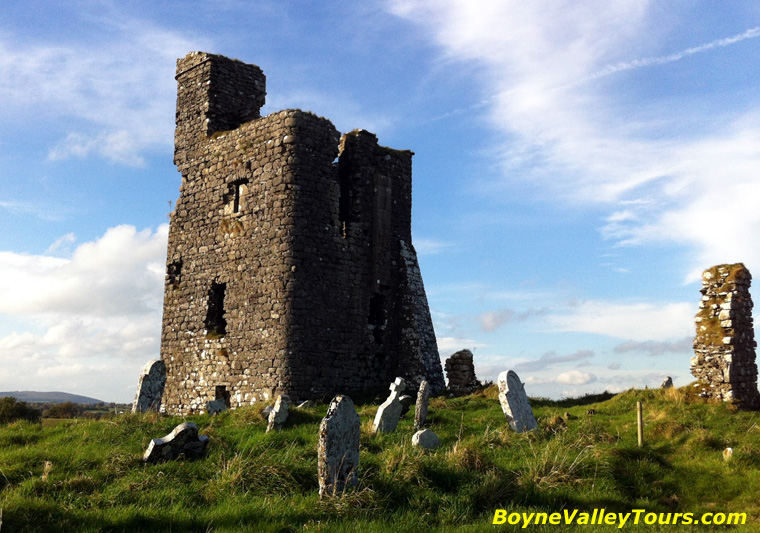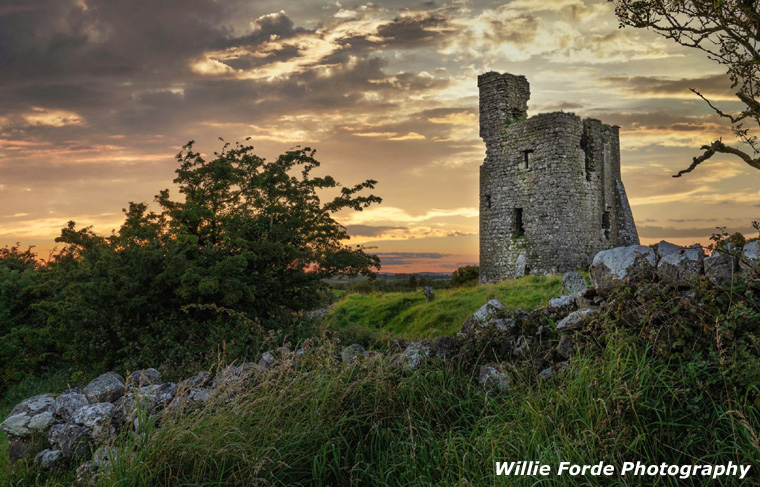The oldest structure at Moylagh is a ring fort, likely serving as the fortified residence of a Celtic chieftain. In the 1170s, the Anglo-Normans arrived and constructed a motte and bailey, crowned by a wooden castle, which was later replaced by a stone castle. The Barnwalls, an Anglo-Norman family, held occupancy of the castle from the 13th to the 17th century. In 1470, a fortified Tower with an attached Church was erected. Presently, the Tower stands as the dominant feature, while only remnants of the church and stone castle remain.
Moylagh - Layers of history
Nestled upon the gentle slopes of Moylagh, a low ridge unfolds, revealing layers of history that stretch back from the Neolithic era to the present day. The proximity of this site to the renowned cairns at Loughcrew suggests a rich tapestry of farming activity during those ancient times.At the heart of Moylagh lies an archaeological treasure — a formidable ring fort, adorned with defensive banks that hint at its role as the fortified residence of a leader from an era possibly dating back to early Christian times. The landscape whispers of a bygone monastic presence, evidenced by the numerous circular ditches that punctuate the surroundings, fostering a sense of sacred seclusion.
In the tapestry of Moylagh's history, the Anglo-Normans make their mark in the 1170s, erecting a motte and bailey upon the landscape's canvas. A wooden castle crowned the motte, possibly enduring until the sixteenth century, when a resilient stone castle takes its place. The Barnwall family, custodians of the castle from 1289 to the 1660s, experienced tragedy in the form of a child's drowning in a bath tub — a poignant detail etched into Moylagh's annals.
Standing proudly amidst the ruins, the tower house, constructed in 1470, graces Moylagh with an air of medieval majesty. It stands tall as the true monument atop the motte. Nearby, the remnants of an old church evoke echoes of times past, its footings a silent testimony to its existence until around 1680. Another church, erected in the late 1700s, echoes the evolution of spiritual spaces on this historic hill.
The landscape around the tower and church reveals a poignant graveyard, a resting place utilized until the 1960s. Here, beneath the earth, lies the final repose of Brian McCormick, the legendary huntsman known as Brianbawn. Rumored to be buried in a standing position, his grave allowed him a perpetual view of the hunt on Grennan Hill. As the 19th century unfolded, the graveyard bore witness to the tragedies of the Great Famine, as victims from the Oldcastle workhouse found their eternal rest in Moylagh's soil.
In 2012, the Moylagh Historical Society erected a monument to commemorate these events, standing as a testament to the enduring allure of this captivating hill. Their accompanying booklet serves as a guide through the intricacies of Moylagh's storied past, inviting all who venture to uncover the layers of history etched into its landscape.
Make an Inquiry or email BoyneValleyTours@gmail.com
Book a Private Day Tour
Boyne Valley Tours Privacy, Terms and Conditions
Book a Private Day Tour
Boyne Valley Tours Privacy, Terms and Conditions
Home
| Private Driver Tour
| Cruise Excursion
| Places
| Ireland's Ancient East
| About Us
| FAQs
| Contact
| Newgrange
| Knowth
| Hill of Tara
| Monasterboice
| Trim Castle
| Mellifont Abbey
| Slane


